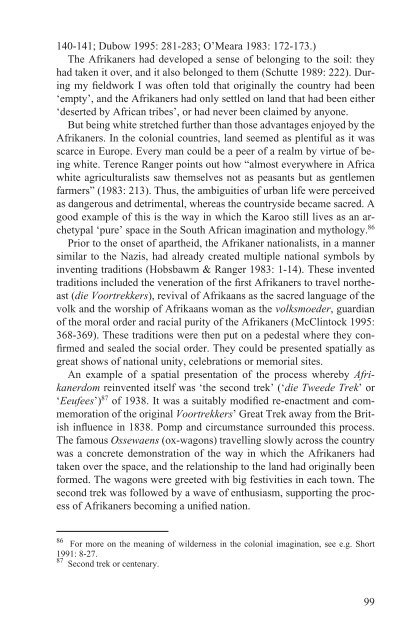The Making of a Good White - E-thesis - Helsinki.fi
The Making of a Good White - E-thesis - Helsinki.fi
The Making of a Good White - E-thesis - Helsinki.fi
Create successful ePaper yourself
Turn your PDF publications into a flip-book with our unique Google optimized e-Paper software.
140-141; Dubow 1995: 281-283; O’Meara 1983: 172-173.)<br />
<strong>The</strong> Afrikaners had developed a sense <strong>of</strong> belonging to the soil: they<br />
had taken it over, and it also belonged to them (Schutte 1989: 222). During<br />
my <strong>fi</strong>eldwork I was <strong>of</strong>ten told that originally the country had been<br />
‘empty’, and the Afrikaners had only settled on land that had been either<br />
‘deserted by African tribes’, or had never been claimed by anyone.<br />
But being white stretched further than those advantages enjoyed by the<br />
Afrikaners. In the colonial countries, land seemed as plentiful as it was<br />
scarce in Europe. Every man could be a peer <strong>of</strong> a realm by virtue <strong>of</strong> being<br />
white. Terence Ranger points out how “almost everywhere in Africa<br />
white agriculturalists saw themselves not as peasants but as gentlemen<br />
farmers” (1983: 213). Thus, the ambiguities <strong>of</strong> urban life were perceived<br />
as dangerous and detrimental, whereas the countryside became sacred. A<br />
good example <strong>of</strong> this is the way in which the Karoo still lives as an archetypal<br />
‘pure’ space in the South African imagination and mythology. 86<br />
Prior to the onset <strong>of</strong> apartheid, the Afrikaner nationalists, in a manner<br />
similar to the Nazis, had already created multiple national symbols by<br />
inventing traditions (Hobsbawm & Ranger 1983: 1-14). <strong>The</strong>se invented<br />
traditions included the veneration <strong>of</strong> the <strong>fi</strong>rst Afrikaners to travel northeast<br />
(die Voortrekkers), revival <strong>of</strong> Afrikaans as the sacred language <strong>of</strong> the<br />
volk and the worship <strong>of</strong> Afrikaans woman as the volksmoeder, guardian<br />
<strong>of</strong> the moral order and racial purity <strong>of</strong> the Afrikaners (McClintock 1995:<br />
368-369). <strong>The</strong>se traditions were then put on a pedestal where they con<strong>fi</strong>rmed<br />
and sealed the social order. <strong>The</strong>y could be presented spatially as<br />
great shows <strong>of</strong> national unity, celebrations or memorial sites.<br />
An example <strong>of</strong> a spatial presentation <strong>of</strong> the process whereby Afrikanerdom<br />
reinvented itself was ‘the second trek’ (‘die Tweede Trek’ or<br />
‘Eeufees’) 87 <strong>of</strong> 1938. It was a suitably modi<strong>fi</strong>ed re-enactment and commemoration<br />
<strong>of</strong> the original Voortrekkers’ Great Trek away from the British<br />
influence in 1838. Pomp and circumstance surrounded this process.<br />
<strong>The</strong> famous Ossewaens (ox-wagons) travelling slowly across the country<br />
was a concrete demonstration <strong>of</strong> the way in which the Afrikaners had<br />
taken over the space, and the relationship to the land had originally been<br />
formed. <strong>The</strong> wagons were greeted with big festivities in each town. <strong>The</strong><br />
second trek was followed by a wave <strong>of</strong> enthusiasm, supporting the process<br />
<strong>of</strong> Afrikaners becoming a uni<strong>fi</strong>ed nation.<br />
86 For more on the meaning <strong>of</strong> wilderness in the colonial imagination, see e.g. Short<br />
1991: 8-27.<br />
87 Second trek or centenary.<br />
99
















